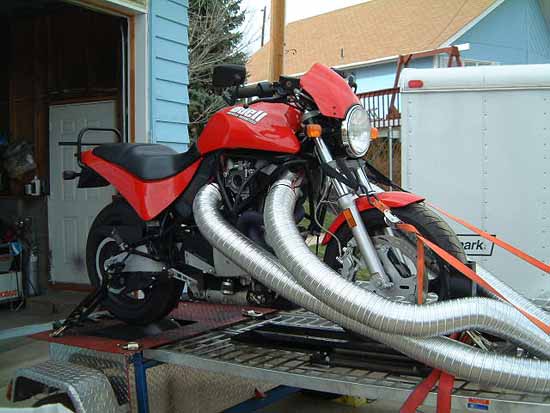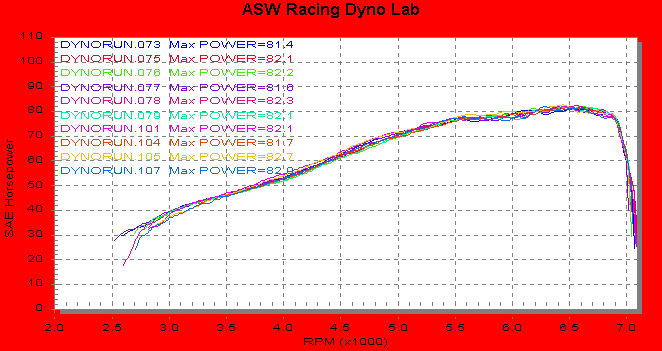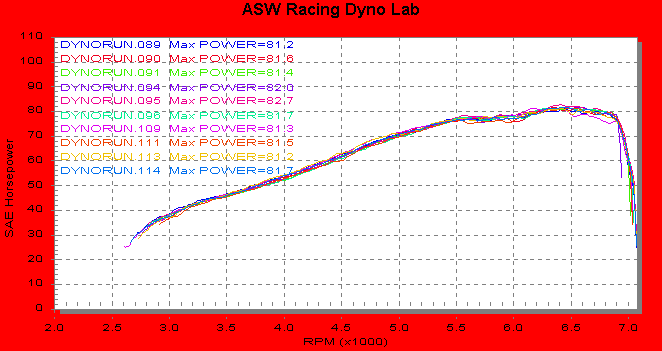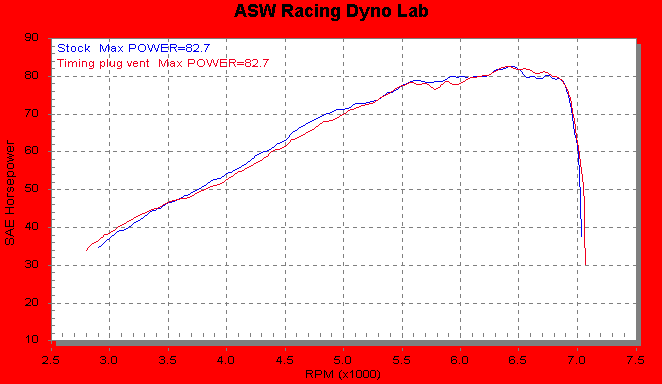| Author |
Message |
    
Blake
| | Posted on Sunday, April 07, 2002 - 01:53 am: | 





|
Very interesting tests. Thanks for sharing them. 
My '97 M2 breather (3/8" line run through catch can/filter and then tail of bike) yields a poot-poot in time with the engine when idling. When blipping quickly to WOT however, nothing exists the breather, similar to your observations of the timing hole vent. The behavior is no different with no tubing at all, monitored at the breather fittings on the heads themselves. I get a poot-poot at idle, but as soon as the throttle is wacked open, nothing. This tells me two things.
1. Blowby is worse at low rpm/low pressure. This actually makes sense, since the rings rely on cylinder pressure to help them effect a seal.
2. My rings are sealing well.
Does that make sense to you? |
    
Steveshakeshaft
| | Posted on Sunday, April 07, 2002 - 12:48 pm: | 





|
Perfect sense, and I'm happy to report that using 1/2" tube into a catch can at the rear number plate location does exactly the same! |
    
Aaron
| | Posted on Sunday, April 07, 2002 - 05:07 pm: | 





|
Here's some more food for thought ...

This is a set of S&S "Special Application" (code for big bore) cases. What I'm holding open is a reed valve that sits in the bottom of the crankcase.
Putting it here makes a lot of sense when you think about it. Crankcase pressure can go out, but not in. Therefore the inlet to the scavenge side of the pump never sees vacuum, only pressure, which helps with scavenging.
I understand they've put a reed valve in the Firebolt's lower end, too, although it's not clear to me exactly where it sits. I suspect they're doing the same thing, helping scavenging.
AW |
    
Peter
| | Posted on Sunday, April 07, 2002 - 05:23 pm: | 





|
Aaron,
Can you show where that breathes to, and, what system they use on their pump/cases to get the oil from the cam cover?
Please?
PPiA |
    
Aaron
| | Posted on Sunday, April 07, 2002 - 08:25 pm: | 





|
Okay, since you said "please" 

Not a lot to see here on the left side. There's a cavity below the crankcase. Notice how there's a scraper integrated into the case, right above the reed valve. Also notice the very tiny drain hole at the bottom of the crankcase, connecting it to the oil pickup area. And of course there are oil feed and drain holes for the sprocket shaft bearings.
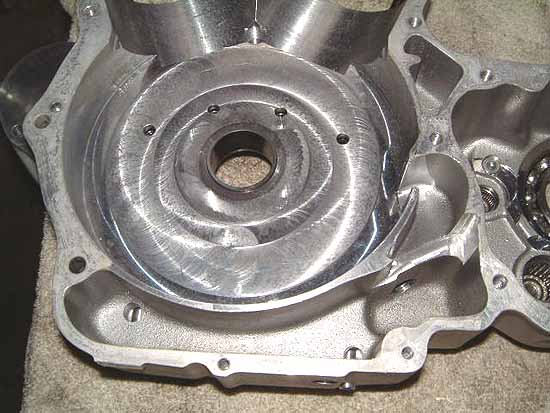
This side is a little more interesting. In the oil collection area, on the far left, is the standard cam box drain hole. The hole on the lower right is the standard pickup location that leads up the the scavenge inlet on the pump. What's interesting is the big hole above and to the right of it, that's another another connection to the cam box, probably more a vent than a drain. Also, you can see the scraper a little better in this picture, directly above that. The 4 holes above the pinion area are the cams.

Here you can plainly see the two drain holes, the big breather one on the left and the standard one on the right. This motor is oiled like the older motors. Instead of coming from the oil filter pad to the tappets, the oil comes in to that fitting on the bottom of the cam box. From there it comes out the hole directly above the fitting, into the cover. It goes up from there and oils the cam bushings. Some of it enters the end of the pinion and eventually makes it's way to the crankpin. Some of it continues up the cover and back into the case at the hole in the top center of the cover mating surface. From here it feeds all 4 lifters through drilled passages. It doesn't have a place where it sprays oil down onto a cam like Evo's, near as I can tell.
The cam chest in these special application cases is offset to the right about 1/2", to make room for the bigger spigots.
That answer your questions? |
    
Peter
| | Posted on Monday, April 08, 2002 - 03:05 am: | 





|
Perfectly. Thank you. 
One last one please, what's the oil pump like? Does it scavange more than a stock one and if so, how?
OK. Two questions. Is the reed valve the same setup that most two stroke bikes use?
PPiA |
    
Aaron
| | Posted on Monday, April 08, 2002 - 08:34 am: | 





|
Peter: You can put whatever kind of pump you want into it. This one had a stock '98 style pump when I got it. Seemed to be working okay.
Yes, that reed valve is pretty similar to what you see in a 2-stroke's intake tract.
These cases are nice pieces. They oughta be for $2K a set. |
    
Peter
| | Posted on Monday, April 08, 2002 - 02:25 pm: | 





|
Hmmm,
If it had a '98 version with the extra inlet at the top of the pump, and still had a drain and that big breather hole to take the oil to the crank area, then I guess that two straw theory is not really an issue?
PPiA |
    
Jmartz
| | Posted on Monday, April 08, 2002 - 03:04 pm: | 





|
AAron:
Those are great pictures of your S&S cases. I was wondering, does Dynojet provide variabilty figures for their dynamometers? By this I mean replicate runs using an induction device other than a motorcycle that could repeat the same energy deposition time after time. Also, have you attemped a repeatability study to dermine a Buell/Dynojet pair distribution of values for what you assume to be the same quantity?
In any case what do you estimate the variabilty to be?
jose |
    
Aaron
| | Posted on Monday, April 08, 2002 - 03:35 pm: | 





|
Peter: you're right, it probably isn't an issue.
Jose: No, I haven't done any studies.
Look at it this way, though. The motor is constantly changing temperature. Plus you have the heat soak effect. So just in the bike, you've got an output that's varying all over the place. That's pretty much what you're looking at above, the bike, not the dyno. And it varies more than that, I did about twice that many pulls in each configuration, that's just the best 10 of each.
I've reached the point where I can pretty much predict whether a pull will be a good one or not, based on how I've been managing the motor's temperature (time between pulls, how much I've been running the fans, how hot I got it last time). I've developed a feel for it, and of course, an awareness of the heat soak effect. Without understanding it, the heat soak effect will really play hell with your results. Understood and managed, it can actually help you get more consistency.
With respect to the dyno's repeatability, the dyno itself is dirt simple, just a drum of a known mass riding on some pillow block bearings, and it has a sensor to tell the computer each time it's completed a revolution. So if the friction in the pillow blocks isn't changing and the mass of the drum isn't changing, what's to cause variability?
No, variation in the dyno's measurement doesn't really come from that, it comes from the correction process, and that's not really an issue in same-day testing. It measures humidity, barometric pressure, and temp, and then modifies the numbers it measures so that you can compare them to numbers taken under other conditions. But, it's an imperfect process.
On the same day in stable weather, it's just not an issue. BUT ... when you take a bike and dyno it on one day, in one set of weather conditions, and then do it again on another day in different weather, even jetted specifically for each day, you'll get a variation. I've seen the same bike vary 5% in it's corrected results due to weather. No changes to the bike other than jetting it properly for each of those two days, and yet I got over a 4 SAE hp difference. That was an extreme case, though. Generally, the same bike in the same state of tune will show within 2 SAE hp on any two given days.
Of course, the uncorrected hp varies a whole bunch more than that. So the correction process at least makes different day runs more comparable.
I generally see correction factors of anywhere between say 1.15 on a cold day to 1.25 on a hot day. So on a cold day, it takes my raw hp measured and increases it by 15%. On a hot day, it may be 25%.
Look at results from sea level locations, they're generally around a 1.00 CF.
AW |
    
Peter
| | Posted on Monday, April 08, 2002 - 05:45 pm: | 





|
Damn. Now I'm getting very confused.
Ron...............?
PPiA |
    
Jmartz
| | Posted on Tuesday, April 09, 2002 - 09:31 am: | 





|
AAron:
With the issue of variability 90% + assigned to the bike though issues of temperature, mostly, how close can you replicate say 10 runs? I would assume you could wait sufficient time beteen attemps in order for the motor to reach the same starting temperature. Is 100 HP + or - 3 possible? Closer? Farther?
This is, of course, hypothetically speaking since you already mentioned you have not attemped a controlled study of the matter.
I would like to now this so the next time my dyno run is dissappointing I have something to blame it on.
Jose |
    
Aaron
| | Posted on Tuesday, April 09, 2002 - 11:28 am: | 





|
Jose: I can't imagine a variation of plus/minus 3 no matter how badly you managed the motor's temp. That's 6hp.
In terms of running it at the same temp, I think that's impossible, even if you could measure it. The motor is different temperatures in different parts of it. How hot you got it before, and whether you're coming down to the desired temp or coming up to the desired temp will make a difference.
What works for me is to do 3-4 pulls at a time (depending on the weather). When I've got the motor at the right temp, I know it because each of those pulls will get a successively lower result. Often it'll take 15 pulls or more to get a bike to that point, even one that's been ridden recently.
In between these sets, I let the motor cool (with the fans running) for 7-8 minutes.
When you've got the motor "in the zone", the first pull of each set will be the best. And you can compare the first pulls to each other and get pretty good repeatibility. Not 100%, but maybe 99%. Generally within a hp if you're managing it correctly.
The total variation, though, from the best pulls to the worst, will be greater. Maybe as much as 3hp total, but generally more like 2 to 2.5. In the this test, I didn't get any pulls in the 79's at all, and the best are 82.7. I had some in the 80's though.
So as you see, when you're talking about potentially small differences like the effect of a breather change, you're really at the mercy of the dyno operator's procedures. If he doesn't manage it correctly, the results are meaningless. Or obviously if he's trying to prove a particular point, he has the power to do that just in which results he chooses to show.
That's exactly why I showed all those results above. I did lots and lots of pulls in both configurations, plus went back and forth between them, and those are literally the 10 best from each configuration, and then the best from each configuration. I did that to demonstrate that I did this honestly, which I did.
Be very skeptical of dyno results, though, if you don't understand the procedures used and the ranges of results achieved, particularly if you think the source of the data has an agenda. |
    
Jmartz
| | Posted on Tuesday, April 09, 2002 - 01:28 pm: | 





|
AAron:
With any instrument that measures a physical (chemical) quantity there are some pretty narrow operating parameters one must ascribe to in order to achieve repetability. I sincerely doubt the typical shop operator follows the scientific protocols you very well understand. 6 in 100 is 6% and 2 in 82 is 2.4% so the system in your hands is significnatly more precise than I anticipated.
I once asked an operator of a dynamic balancing machine to "rebalance" the tire he had just balanced. After several attemps, the machine always found the need to add more weight. That's when I stopped paying $4.95 for the service. The vibration at speed was usually unchanged either way. New rims, fresh tires and a tight suspension cure front end vibration more than any amount of balncing, mostly improper.
Jose |
    
Sarodude
| | Posted on Tuesday, April 09, 2002 - 01:41 pm: | 





|
One thing about corrected dyno numbers...
Corrections based on air density can't account for how the state of tune changes for a given motor. Sure, you can re-jet. However, when air density changes, the tuned lengths of the intake and exhaust change - just as they do with exhaust gas temperature changes. It's more prevalent on 2 strokes but you MAY see the powerband shift slightly left or right depending on stuff...
Anyway...
-Saro |
    
Aaron
| | Posted on Tuesday, April 09, 2002 - 01:56 pm: | 





|
Jose, I agree completely, I suspect dyno's are frequently misused just to make a point or to sell parts. And I also suspect that even people who are honest, but don't understand how to use the thing, arrive at incorrect conclusions.
Much of what I do with the thing I never publish here, I do it for other people, mostly one person in particular (that's why those dynorun files are so high numbered, I had been testing something else). Well, not long ago I tested a magic device that was supposed to improve power (not a breather check valve). I tested it carefully of course, similar to what I've shown above, and it clearly did nothing. Word got back to the manufacturer, who sent me an article that someone else had written up where he *did* find something with the part. But he made the mistake of describing his test procedures in the article, and I could see just by reading it that he didn't understand how to use the dyno, he had set up the perfect conditions to see his results creep up. This guy wasn't experienced with the instrument and didn't understand temperature management or heat soak. I told the manufacturer about the mistake, eventually the guy e-mailed me, I explained it to him too, even sent him Gary Valine's little Battle2win write-up on heat soak (Gary lives in the dyno room from what I hear), but he didn't buy it, he's certain his results were right. Whatever. But it just goes to show you, the tool can be misused.
So whenever I see dyno results and they're trying to show some small difference, I'm immediately skeptical that they didn't do it right. Maybe that's arrogant, I don't know. But I always do my damndest to do a good job. |
    
Blake
| | Posted on Tuesday, April 09, 2002 - 06:16 pm: | 





|
You're arrogant.  |
    
Blake
| | Posted on Tuesday, April 09, 2002 - 06:18 pm: | 





|
You are also right virtually all the time!   |
    
Ralph
| | Posted on Tuesday, April 09, 2002 - 07:09 pm: | 





|
Ain't it just a pain?
bighairyralph |
|
 »
Dyno Test Results - Timing Plug Breather
»
Dyno Test Results - Timing Plug Breather
 »
Dyno Test Results - Timing Plug Breather
»
Dyno Test Results - Timing Plug Breather


